HLT301: Mental State Assessment Workbook Analysis, Semester 1, 2019
VerifiedAdded on 2023/01/06
|11
|3489
|37
Homework Assignment
AI Summary
This assignment analyzes a mental state assessment workbook for the HLT301 course, focusing on a case study of a 38-year-old female, Alison, exhibiting symptoms of major depressive disorder. The assignment addresses key aspects of mental state assessment, including defining the process, analyzing Alison's appearance, behavior, mood, and speech, and differentiating between mood and affect. It identifies physiological signs of depression, explores Alison's thought processes, and examines the significance of her past suicide attempt. Furthermore, the assignment assesses Alison's insight and judgment, identifies current risks such as suicide and addiction, and proposes appropriate interventions, treatment options, and care pathways for her, including both nursing home and home-based care plans. The rationale behind each intervention, such as medication, psychotherapy, and crisis counseling, is also provided. The assignment demonstrates an understanding of mental health assessment and treatment strategies.
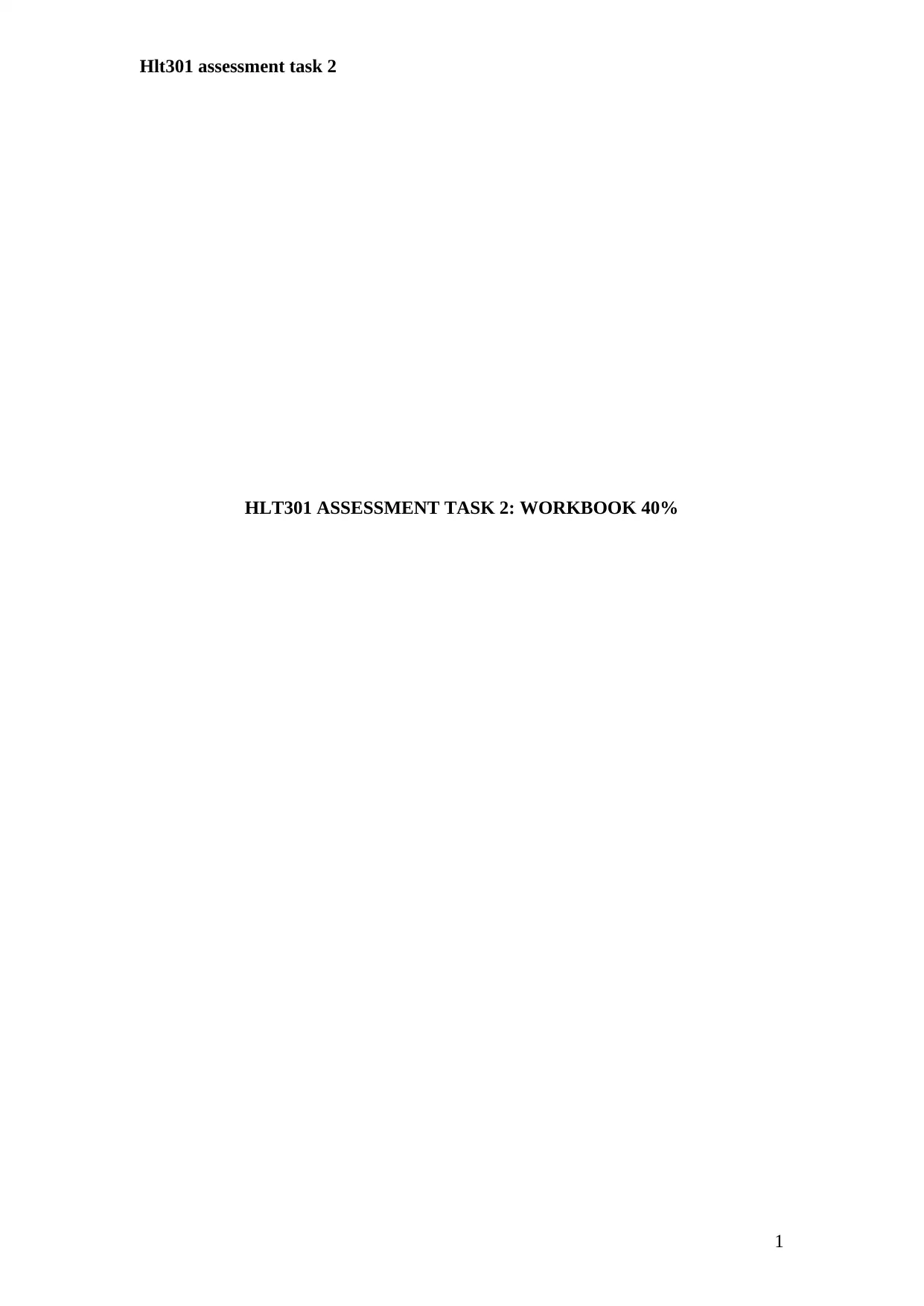
Hlt301 assessment task 2
HLT301 ASSESSMENT TASK 2: WORKBOOK 40%
1
HLT301 ASSESSMENT TASK 2: WORKBOOK 40%
1
Paraphrase This Document
Need a fresh take? Get an instant paraphrase of this document with our AI Paraphraser
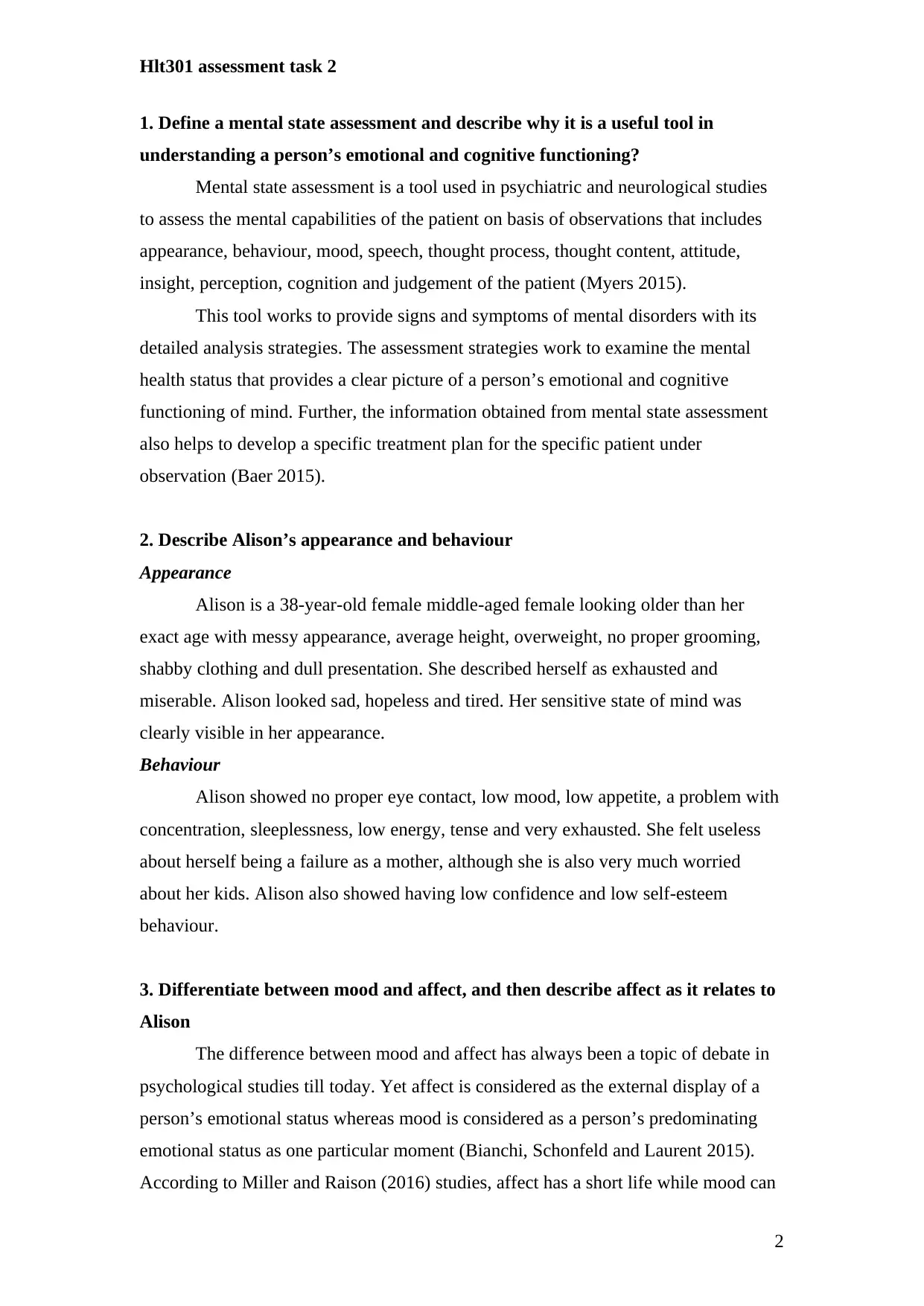
Hlt301 assessment task 2
1. Define a mental state assessment and describe why it is a useful tool in
understanding a person’s emotional and cognitive functioning?
Mental state assessment is a tool used in psychiatric and neurological studies
to assess the mental capabilities of the patient on basis of observations that includes
appearance, behaviour, mood, speech, thought process, thought content, attitude,
insight, perception, cognition and judgement of the patient (Myers 2015).
This tool works to provide signs and symptoms of mental disorders with its
detailed analysis strategies. The assessment strategies work to examine the mental
health status that provides a clear picture of a person’s emotional and cognitive
functioning of mind. Further, the information obtained from mental state assessment
also helps to develop a specific treatment plan for the specific patient under
observation (Baer 2015).
2. Describe Alison’s appearance and behaviour
Appearance
Alison is a 38-year-old female middle-aged female looking older than her
exact age with messy appearance, average height, overweight, no proper grooming,
shabby clothing and dull presentation. She described herself as exhausted and
miserable. Alison looked sad, hopeless and tired. Her sensitive state of mind was
clearly visible in her appearance.
Behaviour
Alison showed no proper eye contact, low mood, low appetite, a problem with
concentration, sleeplessness, low energy, tense and very exhausted. She felt useless
about herself being a failure as a mother, although she is also very much worried
about her kids. Alison also showed having low confidence and low self-esteem
behaviour.
3. Differentiate between mood and affect, and then describe affect as it relates to
Alison
The difference between mood and affect has always been a topic of debate in
psychological studies till today. Yet affect is considered as the external display of a
person’s emotional status whereas mood is considered as a person’s predominating
emotional status as one particular moment (Bianchi, Schonfeld and Laurent 2015).
According to Miller and Raison (2016) studies, affect has a short life while mood can
2
1. Define a mental state assessment and describe why it is a useful tool in
understanding a person’s emotional and cognitive functioning?
Mental state assessment is a tool used in psychiatric and neurological studies
to assess the mental capabilities of the patient on basis of observations that includes
appearance, behaviour, mood, speech, thought process, thought content, attitude,
insight, perception, cognition and judgement of the patient (Myers 2015).
This tool works to provide signs and symptoms of mental disorders with its
detailed analysis strategies. The assessment strategies work to examine the mental
health status that provides a clear picture of a person’s emotional and cognitive
functioning of mind. Further, the information obtained from mental state assessment
also helps to develop a specific treatment plan for the specific patient under
observation (Baer 2015).
2. Describe Alison’s appearance and behaviour
Appearance
Alison is a 38-year-old female middle-aged female looking older than her
exact age with messy appearance, average height, overweight, no proper grooming,
shabby clothing and dull presentation. She described herself as exhausted and
miserable. Alison looked sad, hopeless and tired. Her sensitive state of mind was
clearly visible in her appearance.
Behaviour
Alison showed no proper eye contact, low mood, low appetite, a problem with
concentration, sleeplessness, low energy, tense and very exhausted. She felt useless
about herself being a failure as a mother, although she is also very much worried
about her kids. Alison also showed having low confidence and low self-esteem
behaviour.
3. Differentiate between mood and affect, and then describe affect as it relates to
Alison
The difference between mood and affect has always been a topic of debate in
psychological studies till today. Yet affect is considered as the external display of a
person’s emotional status whereas mood is considered as a person’s predominating
emotional status as one particular moment (Bianchi, Schonfeld and Laurent 2015).
According to Miller and Raison (2016) studies, affect has a short life while mood can
2
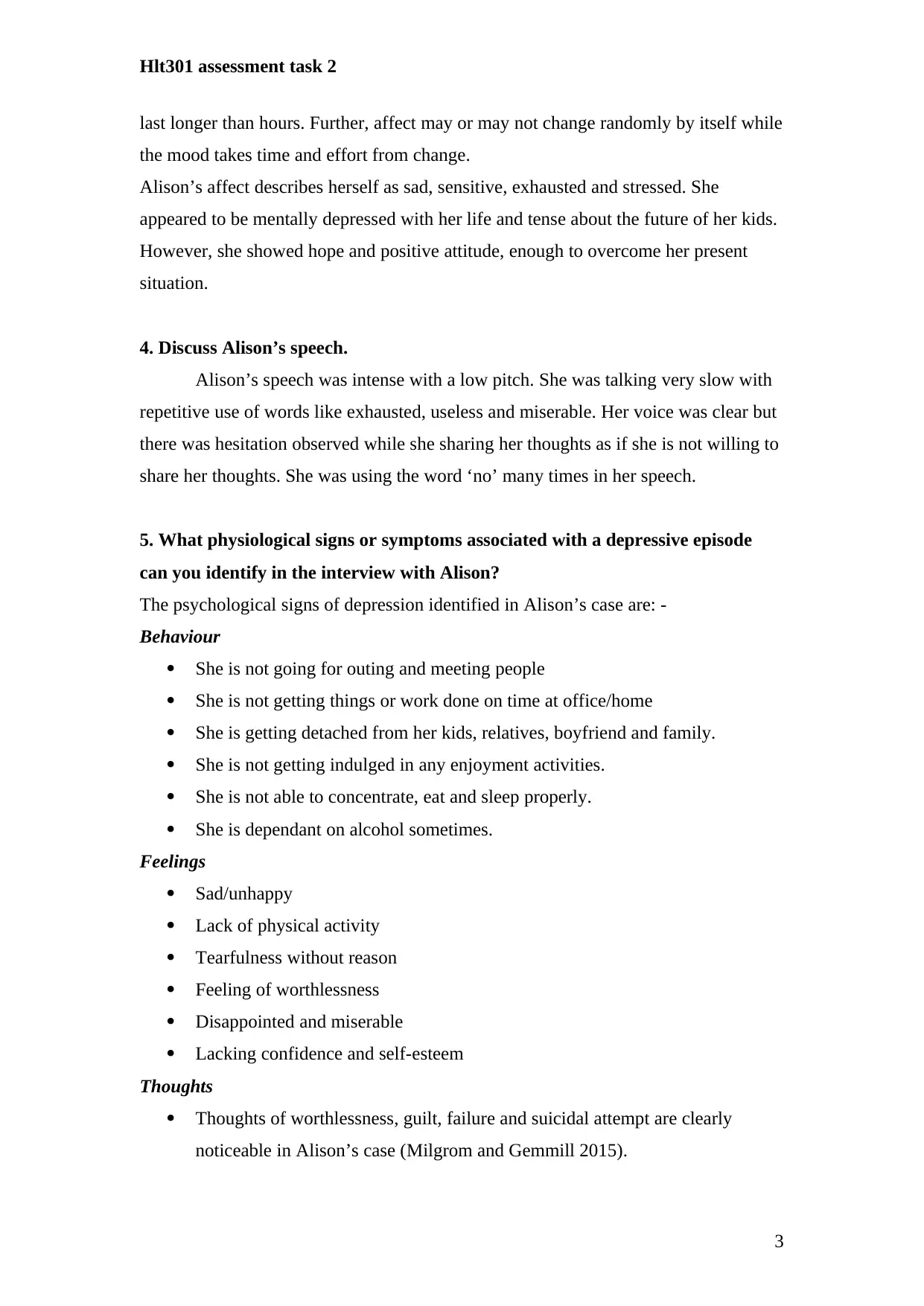
Hlt301 assessment task 2
last longer than hours. Further, affect may or may not change randomly by itself while
the mood takes time and effort from change.
Alison’s affect describes herself as sad, sensitive, exhausted and stressed. She
appeared to be mentally depressed with her life and tense about the future of her kids.
However, she showed hope and positive attitude, enough to overcome her present
situation.
4. Discuss Alison’s speech.
Alison’s speech was intense with a low pitch. She was talking very slow with
repetitive use of words like exhausted, useless and miserable. Her voice was clear but
there was hesitation observed while she sharing her thoughts as if she is not willing to
share her thoughts. She was using the word ‘no’ many times in her speech.
5. What physiological signs or symptoms associated with a depressive episode
can you identify in the interview with Alison?
The psychological signs of depression identified in Alison’s case are: -
Behaviour
She is not going for outing and meeting people
She is not getting things or work done on time at office/home
She is getting detached from her kids, relatives, boyfriend and family.
She is not getting indulged in any enjoyment activities.
She is not able to concentrate, eat and sleep properly.
She is dependant on alcohol sometimes.
Feelings
Sad/unhappy
Lack of physical activity
Tearfulness without reason
Feeling of worthlessness
Disappointed and miserable
Lacking confidence and self-esteem
Thoughts
Thoughts of worthlessness, guilt, failure and suicidal attempt are clearly
noticeable in Alison’s case (Milgrom and Gemmill 2015).
3
last longer than hours. Further, affect may or may not change randomly by itself while
the mood takes time and effort from change.
Alison’s affect describes herself as sad, sensitive, exhausted and stressed. She
appeared to be mentally depressed with her life and tense about the future of her kids.
However, she showed hope and positive attitude, enough to overcome her present
situation.
4. Discuss Alison’s speech.
Alison’s speech was intense with a low pitch. She was talking very slow with
repetitive use of words like exhausted, useless and miserable. Her voice was clear but
there was hesitation observed while she sharing her thoughts as if she is not willing to
share her thoughts. She was using the word ‘no’ many times in her speech.
5. What physiological signs or symptoms associated with a depressive episode
can you identify in the interview with Alison?
The psychological signs of depression identified in Alison’s case are: -
Behaviour
She is not going for outing and meeting people
She is not getting things or work done on time at office/home
She is getting detached from her kids, relatives, boyfriend and family.
She is not getting indulged in any enjoyment activities.
She is not able to concentrate, eat and sleep properly.
She is dependant on alcohol sometimes.
Feelings
Sad/unhappy
Lack of physical activity
Tearfulness without reason
Feeling of worthlessness
Disappointed and miserable
Lacking confidence and self-esteem
Thoughts
Thoughts of worthlessness, guilt, failure and suicidal attempt are clearly
noticeable in Alison’s case (Milgrom and Gemmill 2015).
3
⊘ This is a preview!⊘
Do you want full access?
Subscribe today to unlock all pages.

Trusted by 1+ million students worldwide
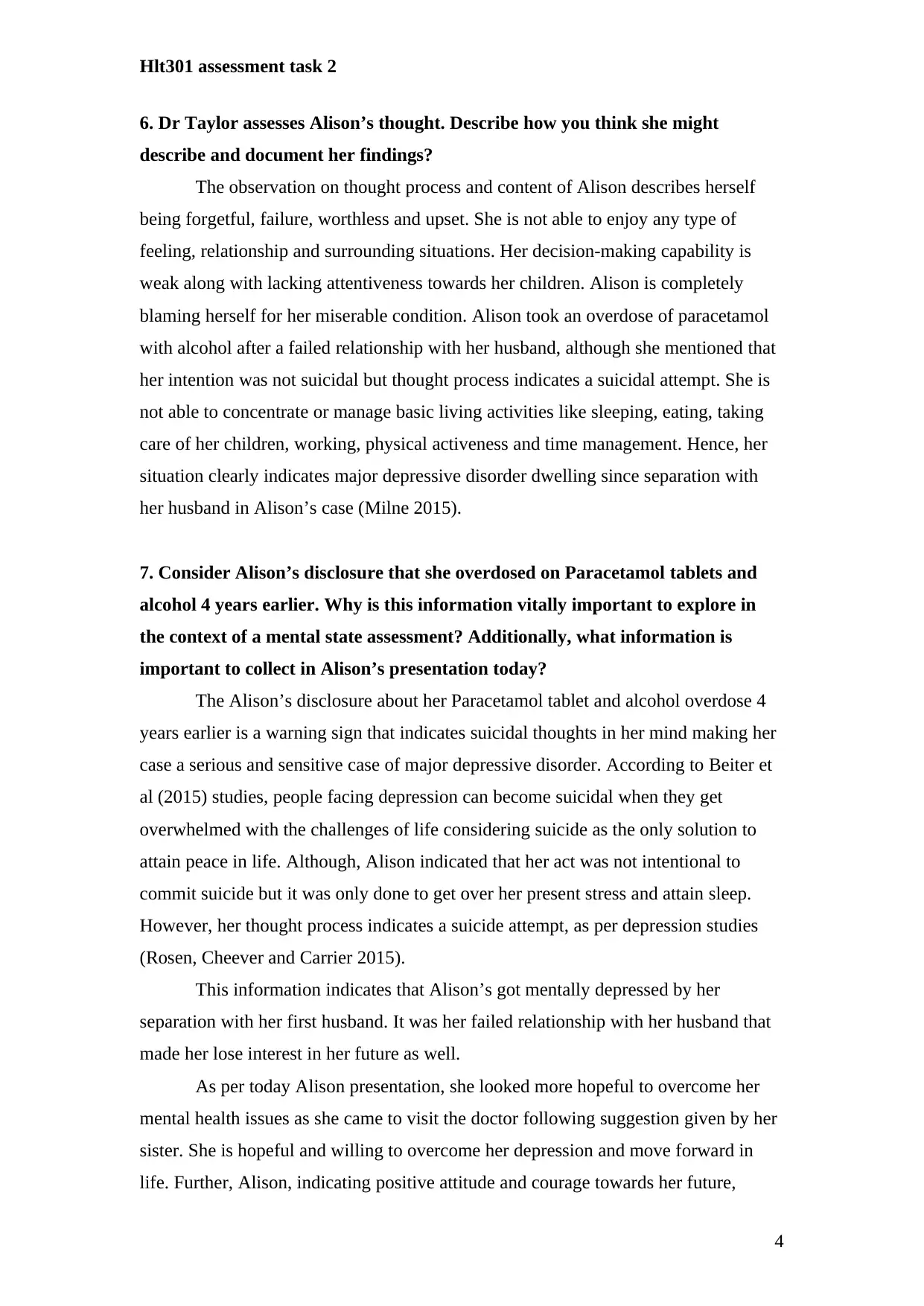
Hlt301 assessment task 2
6. Dr Taylor assesses Alison’s thought. Describe how you think she might
describe and document her findings?
The observation on thought process and content of Alison describes herself
being forgetful, failure, worthless and upset. She is not able to enjoy any type of
feeling, relationship and surrounding situations. Her decision-making capability is
weak along with lacking attentiveness towards her children. Alison is completely
blaming herself for her miserable condition. Alison took an overdose of paracetamol
with alcohol after a failed relationship with her husband, although she mentioned that
her intention was not suicidal but thought process indicates a suicidal attempt. She is
not able to concentrate or manage basic living activities like sleeping, eating, taking
care of her children, working, physical activeness and time management. Hence, her
situation clearly indicates major depressive disorder dwelling since separation with
her husband in Alison’s case (Milne 2015).
7. Consider Alison’s disclosure that she overdosed on Paracetamol tablets and
alcohol 4 years earlier. Why is this information vitally important to explore in
the context of a mental state assessment? Additionally, what information is
important to collect in Alison’s presentation today?
The Alison’s disclosure about her Paracetamol tablet and alcohol overdose 4
years earlier is a warning sign that indicates suicidal thoughts in her mind making her
case a serious and sensitive case of major depressive disorder. According to Beiter et
al (2015) studies, people facing depression can become suicidal when they get
overwhelmed with the challenges of life considering suicide as the only solution to
attain peace in life. Although, Alison indicated that her act was not intentional to
commit suicide but it was only done to get over her present stress and attain sleep.
However, her thought process indicates a suicide attempt, as per depression studies
(Rosen, Cheever and Carrier 2015).
This information indicates that Alison’s got mentally depressed by her
separation with her first husband. It was her failed relationship with her husband that
made her lose interest in her future as well.
As per today Alison presentation, she looked more hopeful to overcome her
mental health issues as she came to visit the doctor following suggestion given by her
sister. She is hopeful and willing to overcome her depression and move forward in
life. Further, Alison, indicating positive attitude and courage towards her future,
4
6. Dr Taylor assesses Alison’s thought. Describe how you think she might
describe and document her findings?
The observation on thought process and content of Alison describes herself
being forgetful, failure, worthless and upset. She is not able to enjoy any type of
feeling, relationship and surrounding situations. Her decision-making capability is
weak along with lacking attentiveness towards her children. Alison is completely
blaming herself for her miserable condition. Alison took an overdose of paracetamol
with alcohol after a failed relationship with her husband, although she mentioned that
her intention was not suicidal but thought process indicates a suicidal attempt. She is
not able to concentrate or manage basic living activities like sleeping, eating, taking
care of her children, working, physical activeness and time management. Hence, her
situation clearly indicates major depressive disorder dwelling since separation with
her husband in Alison’s case (Milne 2015).
7. Consider Alison’s disclosure that she overdosed on Paracetamol tablets and
alcohol 4 years earlier. Why is this information vitally important to explore in
the context of a mental state assessment? Additionally, what information is
important to collect in Alison’s presentation today?
The Alison’s disclosure about her Paracetamol tablet and alcohol overdose 4
years earlier is a warning sign that indicates suicidal thoughts in her mind making her
case a serious and sensitive case of major depressive disorder. According to Beiter et
al (2015) studies, people facing depression can become suicidal when they get
overwhelmed with the challenges of life considering suicide as the only solution to
attain peace in life. Although, Alison indicated that her act was not intentional to
commit suicide but it was only done to get over her present stress and attain sleep.
However, her thought process indicates a suicide attempt, as per depression studies
(Rosen, Cheever and Carrier 2015).
This information indicates that Alison’s got mentally depressed by her
separation with her first husband. It was her failed relationship with her husband that
made her lose interest in her future as well.
As per today Alison presentation, she looked more hopeful to overcome her
mental health issues as she came to visit the doctor following suggestion given by her
sister. She is hopeful and willing to overcome her depression and move forward in
life. Further, Alison, indicating positive attitude and courage towards her future,
4
Paraphrase This Document
Need a fresh take? Get an instant paraphrase of this document with our AI Paraphraser
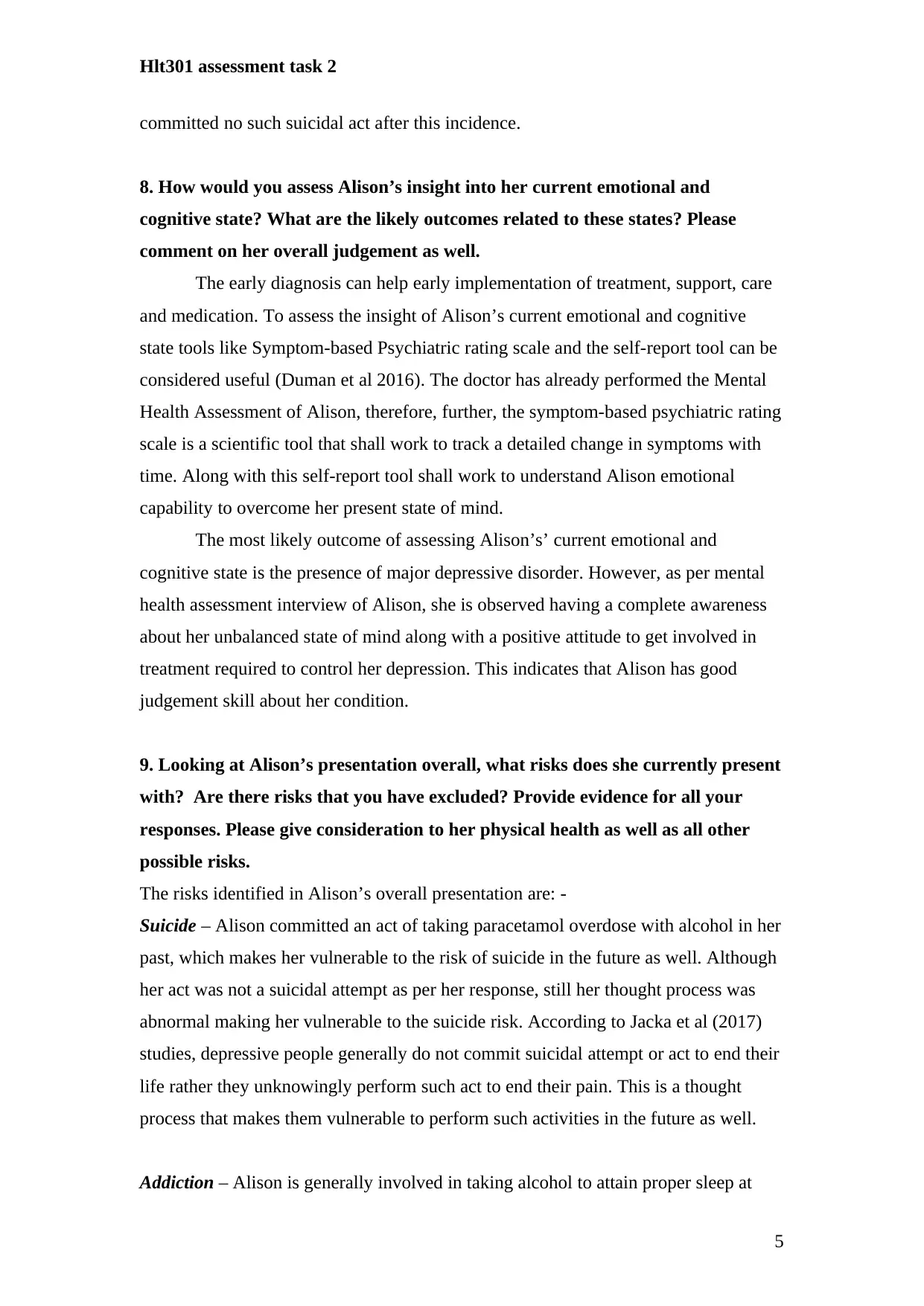
Hlt301 assessment task 2
committed no such suicidal act after this incidence.
8. How would you assess Alison’s insight into her current emotional and
cognitive state? What are the likely outcomes related to these states? Please
comment on her overall judgement as well.
The early diagnosis can help early implementation of treatment, support, care
and medication. To assess the insight of Alison’s current emotional and cognitive
state tools like Symptom-based Psychiatric rating scale and the self-report tool can be
considered useful (Duman et al 2016). The doctor has already performed the Mental
Health Assessment of Alison, therefore, further, the symptom-based psychiatric rating
scale is a scientific tool that shall work to track a detailed change in symptoms with
time. Along with this self-report tool shall work to understand Alison emotional
capability to overcome her present state of mind.
The most likely outcome of assessing Alison’s’ current emotional and
cognitive state is the presence of major depressive disorder. However, as per mental
health assessment interview of Alison, she is observed having a complete awareness
about her unbalanced state of mind along with a positive attitude to get involved in
treatment required to control her depression. This indicates that Alison has good
judgement skill about her condition.
9. Looking at Alison’s presentation overall, what risks does she currently present
with? Are there risks that you have excluded? Provide evidence for all your
responses. Please give consideration to her physical health as well as all other
possible risks.
The risks identified in Alison’s overall presentation are: -
Suicide – Alison committed an act of taking paracetamol overdose with alcohol in her
past, which makes her vulnerable to the risk of suicide in the future as well. Although
her act was not a suicidal attempt as per her response, still her thought process was
abnormal making her vulnerable to the suicide risk. According to Jacka et al (2017)
studies, depressive people generally do not commit suicidal attempt or act to end their
life rather they unknowingly perform such act to end their pain. This is a thought
process that makes them vulnerable to perform such activities in the future as well.
Addiction – Alison is generally involved in taking alcohol to attain proper sleep at
5
committed no such suicidal act after this incidence.
8. How would you assess Alison’s insight into her current emotional and
cognitive state? What are the likely outcomes related to these states? Please
comment on her overall judgement as well.
The early diagnosis can help early implementation of treatment, support, care
and medication. To assess the insight of Alison’s current emotional and cognitive
state tools like Symptom-based Psychiatric rating scale and the self-report tool can be
considered useful (Duman et al 2016). The doctor has already performed the Mental
Health Assessment of Alison, therefore, further, the symptom-based psychiatric rating
scale is a scientific tool that shall work to track a detailed change in symptoms with
time. Along with this self-report tool shall work to understand Alison emotional
capability to overcome her present state of mind.
The most likely outcome of assessing Alison’s’ current emotional and
cognitive state is the presence of major depressive disorder. However, as per mental
health assessment interview of Alison, she is observed having a complete awareness
about her unbalanced state of mind along with a positive attitude to get involved in
treatment required to control her depression. This indicates that Alison has good
judgement skill about her condition.
9. Looking at Alison’s presentation overall, what risks does she currently present
with? Are there risks that you have excluded? Provide evidence for all your
responses. Please give consideration to her physical health as well as all other
possible risks.
The risks identified in Alison’s overall presentation are: -
Suicide – Alison committed an act of taking paracetamol overdose with alcohol in her
past, which makes her vulnerable to the risk of suicide in the future as well. Although
her act was not a suicidal attempt as per her response, still her thought process was
abnormal making her vulnerable to the suicide risk. According to Jacka et al (2017)
studies, depressive people generally do not commit suicidal attempt or act to end their
life rather they unknowingly perform such act to end their pain. This is a thought
process that makes them vulnerable to perform such activities in the future as well.
Addiction – Alison is generally involved in taking alcohol to attain proper sleep at
5
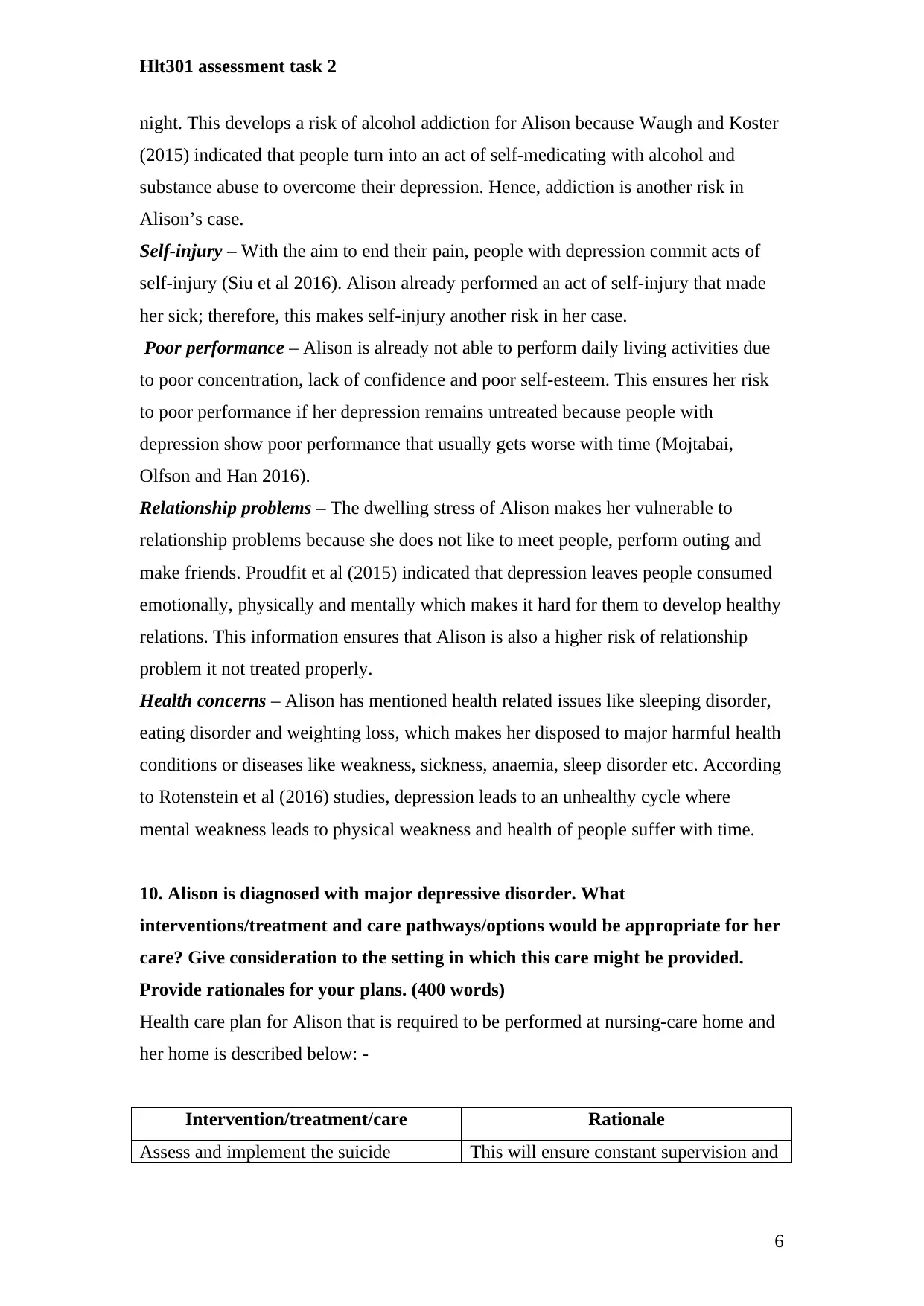
Hlt301 assessment task 2
night. This develops a risk of alcohol addiction for Alison because Waugh and Koster
(2015) indicated that people turn into an act of self-medicating with alcohol and
substance abuse to overcome their depression. Hence, addiction is another risk in
Alison’s case.
Self-injury – With the aim to end their pain, people with depression commit acts of
self-injury (Siu et al 2016). Alison already performed an act of self-injury that made
her sick; therefore, this makes self-injury another risk in her case.
Poor performance – Alison is already not able to perform daily living activities due
to poor concentration, lack of confidence and poor self-esteem. This ensures her risk
to poor performance if her depression remains untreated because people with
depression show poor performance that usually gets worse with time (Mojtabai,
Olfson and Han 2016).
Relationship problems – The dwelling stress of Alison makes her vulnerable to
relationship problems because she does not like to meet people, perform outing and
make friends. Proudfit et al (2015) indicated that depression leaves people consumed
emotionally, physically and mentally which makes it hard for them to develop healthy
relations. This information ensures that Alison is also a higher risk of relationship
problem it not treated properly.
Health concerns – Alison has mentioned health related issues like sleeping disorder,
eating disorder and weighting loss, which makes her disposed to major harmful health
conditions or diseases like weakness, sickness, anaemia, sleep disorder etc. According
to Rotenstein et al (2016) studies, depression leads to an unhealthy cycle where
mental weakness leads to physical weakness and health of people suffer with time.
10. Alison is diagnosed with major depressive disorder. What
interventions/treatment and care pathways/options would be appropriate for her
care? Give consideration to the setting in which this care might be provided.
Provide rationales for your plans. (400 words)
Health care plan for Alison that is required to be performed at nursing-care home and
her home is described below: -
Intervention/treatment/care Rationale
Assess and implement the suicide This will ensure constant supervision and
6
night. This develops a risk of alcohol addiction for Alison because Waugh and Koster
(2015) indicated that people turn into an act of self-medicating with alcohol and
substance abuse to overcome their depression. Hence, addiction is another risk in
Alison’s case.
Self-injury – With the aim to end their pain, people with depression commit acts of
self-injury (Siu et al 2016). Alison already performed an act of self-injury that made
her sick; therefore, this makes self-injury another risk in her case.
Poor performance – Alison is already not able to perform daily living activities due
to poor concentration, lack of confidence and poor self-esteem. This ensures her risk
to poor performance if her depression remains untreated because people with
depression show poor performance that usually gets worse with time (Mojtabai,
Olfson and Han 2016).
Relationship problems – The dwelling stress of Alison makes her vulnerable to
relationship problems because she does not like to meet people, perform outing and
make friends. Proudfit et al (2015) indicated that depression leaves people consumed
emotionally, physically and mentally which makes it hard for them to develop healthy
relations. This information ensures that Alison is also a higher risk of relationship
problem it not treated properly.
Health concerns – Alison has mentioned health related issues like sleeping disorder,
eating disorder and weighting loss, which makes her disposed to major harmful health
conditions or diseases like weakness, sickness, anaemia, sleep disorder etc. According
to Rotenstein et al (2016) studies, depression leads to an unhealthy cycle where
mental weakness leads to physical weakness and health of people suffer with time.
10. Alison is diagnosed with major depressive disorder. What
interventions/treatment and care pathways/options would be appropriate for her
care? Give consideration to the setting in which this care might be provided.
Provide rationales for your plans. (400 words)
Health care plan for Alison that is required to be performed at nursing-care home and
her home is described below: -
Intervention/treatment/care Rationale
Assess and implement the suicide This will ensure constant supervision and
6
⊘ This is a preview!⊘
Do you want full access?
Subscribe today to unlock all pages.

Trusted by 1+ million students worldwide
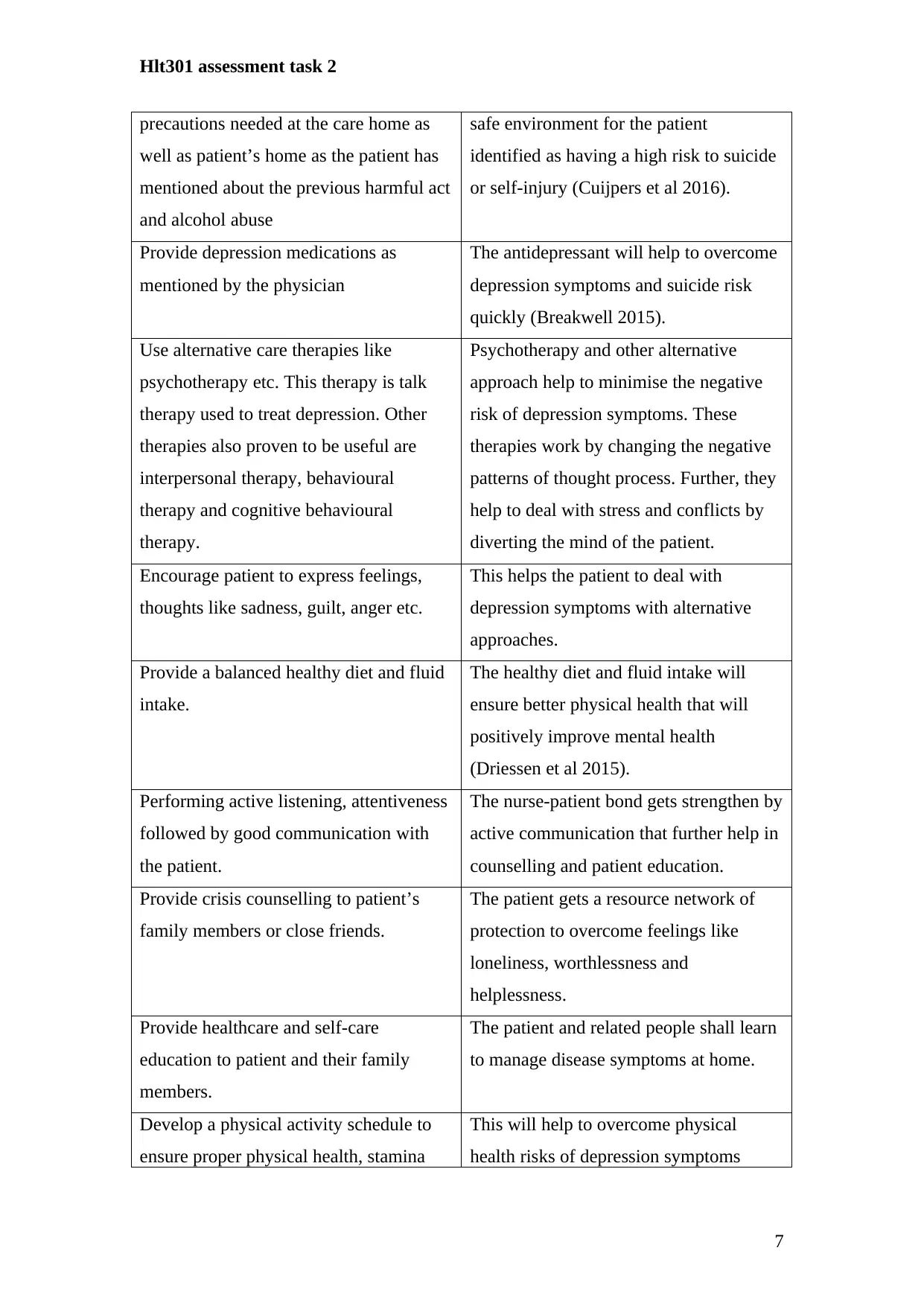
Hlt301 assessment task 2
precautions needed at the care home as
well as patient’s home as the patient has
mentioned about the previous harmful act
and alcohol abuse
safe environment for the patient
identified as having a high risk to suicide
or self-injury (Cuijpers et al 2016).
Provide depression medications as
mentioned by the physician
The antidepressant will help to overcome
depression symptoms and suicide risk
quickly (Breakwell 2015).
Use alternative care therapies like
psychotherapy etc. This therapy is talk
therapy used to treat depression. Other
therapies also proven to be useful are
interpersonal therapy, behavioural
therapy and cognitive behavioural
therapy.
Psychotherapy and other alternative
approach help to minimise the negative
risk of depression symptoms. These
therapies work by changing the negative
patterns of thought process. Further, they
help to deal with stress and conflicts by
diverting the mind of the patient.
Encourage patient to express feelings,
thoughts like sadness, guilt, anger etc.
This helps the patient to deal with
depression symptoms with alternative
approaches.
Provide a balanced healthy diet and fluid
intake.
The healthy diet and fluid intake will
ensure better physical health that will
positively improve mental health
(Driessen et al 2015).
Performing active listening, attentiveness
followed by good communication with
the patient.
The nurse-patient bond gets strengthen by
active communication that further help in
counselling and patient education.
Provide crisis counselling to patient’s
family members or close friends.
The patient gets a resource network of
protection to overcome feelings like
loneliness, worthlessness and
helplessness.
Provide healthcare and self-care
education to patient and their family
members.
The patient and related people shall learn
to manage disease symptoms at home.
Develop a physical activity schedule to
ensure proper physical health, stamina
This will help to overcome physical
health risks of depression symptoms
7
precautions needed at the care home as
well as patient’s home as the patient has
mentioned about the previous harmful act
and alcohol abuse
safe environment for the patient
identified as having a high risk to suicide
or self-injury (Cuijpers et al 2016).
Provide depression medications as
mentioned by the physician
The antidepressant will help to overcome
depression symptoms and suicide risk
quickly (Breakwell 2015).
Use alternative care therapies like
psychotherapy etc. This therapy is talk
therapy used to treat depression. Other
therapies also proven to be useful are
interpersonal therapy, behavioural
therapy and cognitive behavioural
therapy.
Psychotherapy and other alternative
approach help to minimise the negative
risk of depression symptoms. These
therapies work by changing the negative
patterns of thought process. Further, they
help to deal with stress and conflicts by
diverting the mind of the patient.
Encourage patient to express feelings,
thoughts like sadness, guilt, anger etc.
This helps the patient to deal with
depression symptoms with alternative
approaches.
Provide a balanced healthy diet and fluid
intake.
The healthy diet and fluid intake will
ensure better physical health that will
positively improve mental health
(Driessen et al 2015).
Performing active listening, attentiveness
followed by good communication with
the patient.
The nurse-patient bond gets strengthen by
active communication that further help in
counselling and patient education.
Provide crisis counselling to patient’s
family members or close friends.
The patient gets a resource network of
protection to overcome feelings like
loneliness, worthlessness and
helplessness.
Provide healthcare and self-care
education to patient and their family
members.
The patient and related people shall learn
to manage disease symptoms at home.
Develop a physical activity schedule to
ensure proper physical health, stamina
This will help to overcome physical
health risks of depression symptoms
7
Paraphrase This Document
Need a fresh take? Get an instant paraphrase of this document with our AI Paraphraser
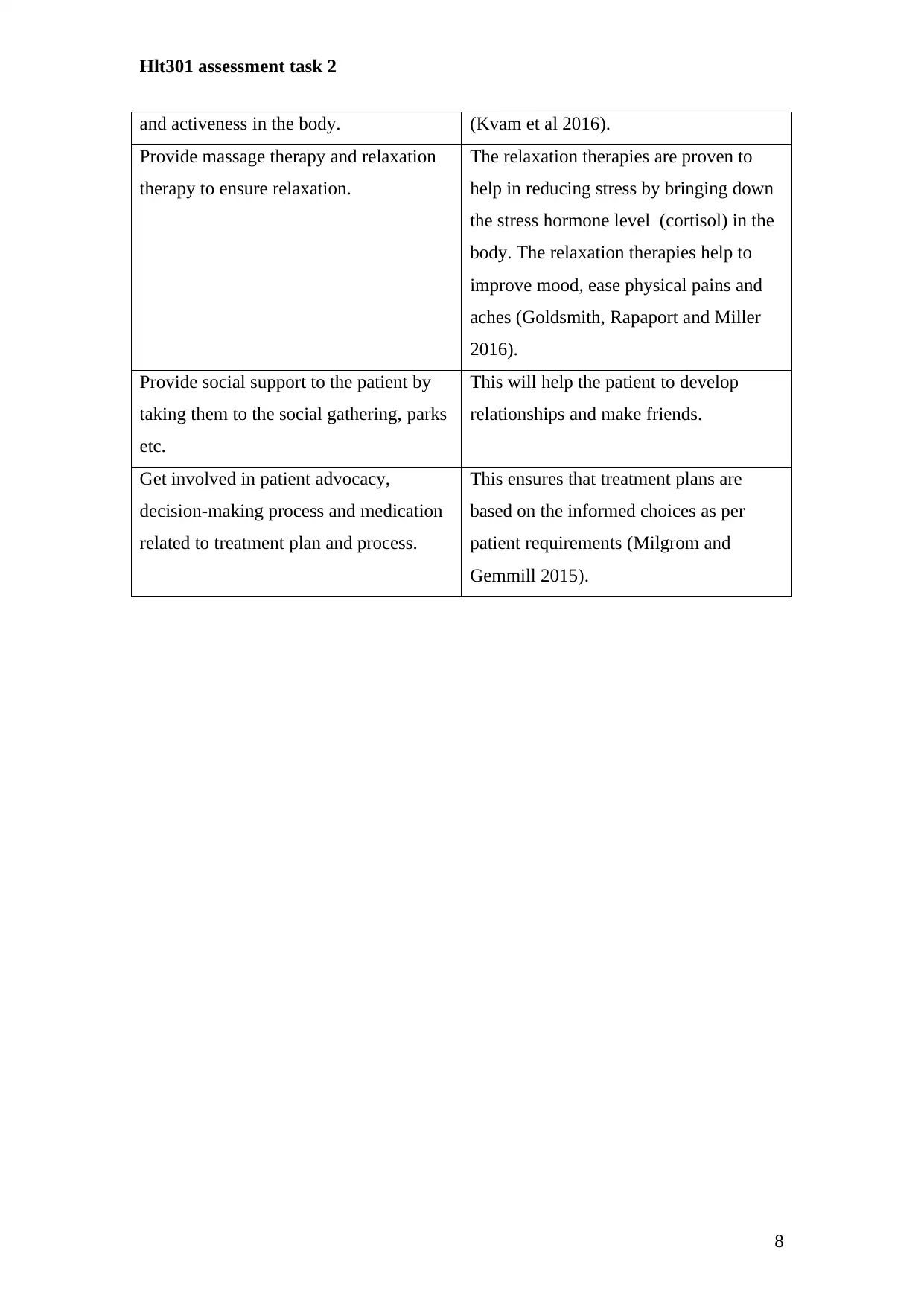
Hlt301 assessment task 2
and activeness in the body. (Kvam et al 2016).
Provide massage therapy and relaxation
therapy to ensure relaxation.
The relaxation therapies are proven to
help in reducing stress by bringing down
the stress hormone level (cortisol) in the
body. The relaxation therapies help to
improve mood, ease physical pains and
aches (Goldsmith, Rapaport and Miller
2016).
Provide social support to the patient by
taking them to the social gathering, parks
etc.
This will help the patient to develop
relationships and make friends.
Get involved in patient advocacy,
decision-making process and medication
related to treatment plan and process.
This ensures that treatment plans are
based on the informed choices as per
patient requirements (Milgrom and
Gemmill 2015).
8
and activeness in the body. (Kvam et al 2016).
Provide massage therapy and relaxation
therapy to ensure relaxation.
The relaxation therapies are proven to
help in reducing stress by bringing down
the stress hormone level (cortisol) in the
body. The relaxation therapies help to
improve mood, ease physical pains and
aches (Goldsmith, Rapaport and Miller
2016).
Provide social support to the patient by
taking them to the social gathering, parks
etc.
This will help the patient to develop
relationships and make friends.
Get involved in patient advocacy,
decision-making process and medication
related to treatment plan and process.
This ensures that treatment plans are
based on the informed choices as per
patient requirements (Milgrom and
Gemmill 2015).
8
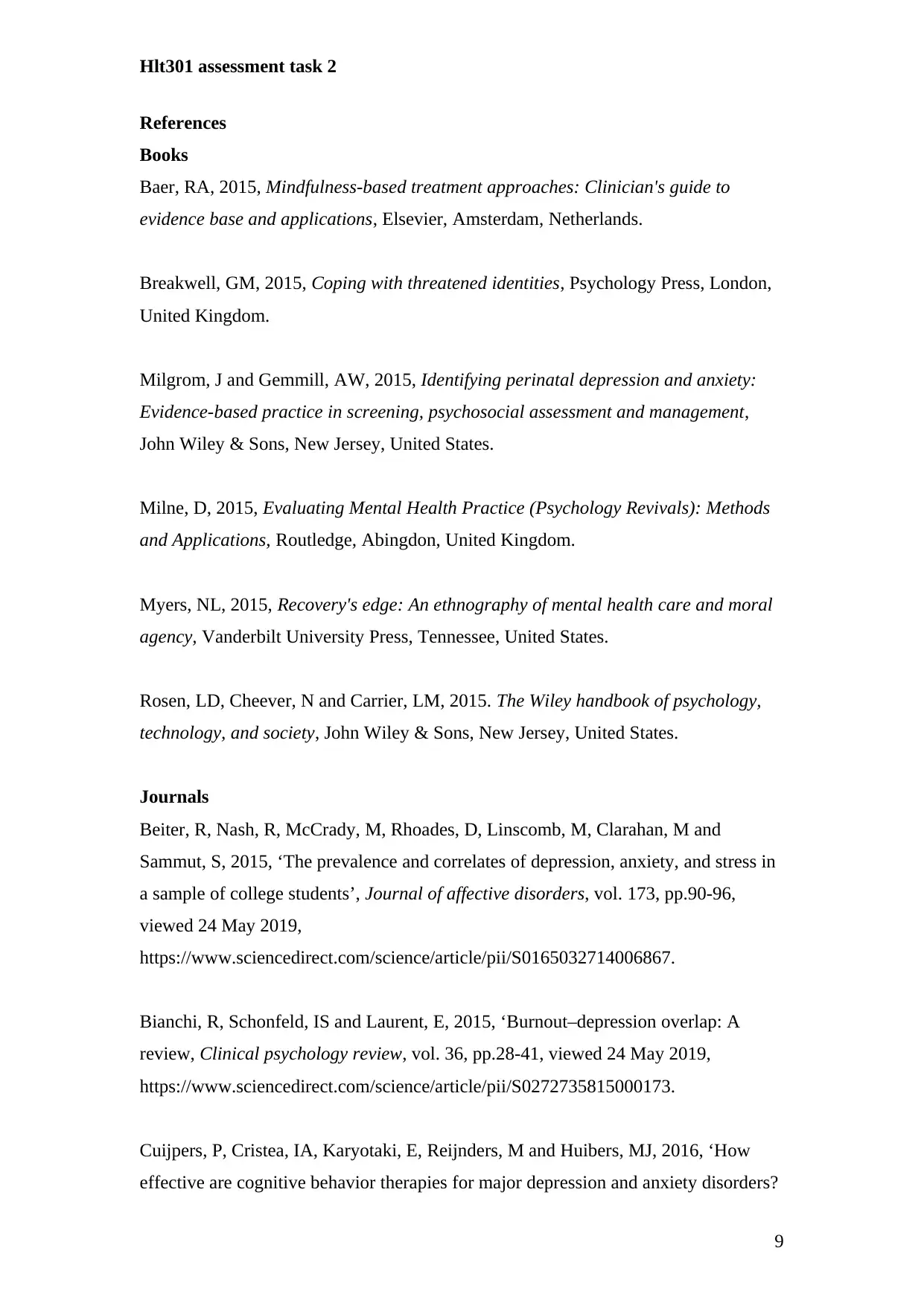
Hlt301 assessment task 2
References
Books
Baer, RA, 2015, Mindfulness-based treatment approaches: Clinician's guide to
evidence base and applications, Elsevier, Amsterdam, Netherlands.
Breakwell, GM, 2015, Coping with threatened identities, Psychology Press, London,
United Kingdom.
Milgrom, J and Gemmill, AW, 2015, Identifying perinatal depression and anxiety:
Evidence-based practice in screening, psychosocial assessment and management,
John Wiley & Sons, New Jersey, United States.
Milne, D, 2015, Evaluating Mental Health Practice (Psychology Revivals): Methods
and Applications, Routledge, Abingdon, United Kingdom.
Myers, NL, 2015, Recovery's edge: An ethnography of mental health care and moral
agency, Vanderbilt University Press, Tennessee, United States.
Rosen, LD, Cheever, N and Carrier, LM, 2015. The Wiley handbook of psychology,
technology, and society, John Wiley & Sons, New Jersey, United States.
Journals
Beiter, R, Nash, R, McCrady, M, Rhoades, D, Linscomb, M, Clarahan, M and
Sammut, S, 2015, ‘The prevalence and correlates of depression, anxiety, and stress in
a sample of college students’, Journal of affective disorders, vol. 173, pp.90-96,
viewed 24 May 2019,
https://www.sciencedirect.com/science/article/pii/S0165032714006867.
Bianchi, R, Schonfeld, IS and Laurent, E, 2015, ‘Burnout–depression overlap: A
review, Clinical psychology review, vol. 36, pp.28-41, viewed 24 May 2019,
https://www.sciencedirect.com/science/article/pii/S0272735815000173.
Cuijpers, P, Cristea, IA, Karyotaki, E, Reijnders, M and Huibers, MJ, 2016, ‘How
effective are cognitive behavior therapies for major depression and anxiety disorders?
9
References
Books
Baer, RA, 2015, Mindfulness-based treatment approaches: Clinician's guide to
evidence base and applications, Elsevier, Amsterdam, Netherlands.
Breakwell, GM, 2015, Coping with threatened identities, Psychology Press, London,
United Kingdom.
Milgrom, J and Gemmill, AW, 2015, Identifying perinatal depression and anxiety:
Evidence-based practice in screening, psychosocial assessment and management,
John Wiley & Sons, New Jersey, United States.
Milne, D, 2015, Evaluating Mental Health Practice (Psychology Revivals): Methods
and Applications, Routledge, Abingdon, United Kingdom.
Myers, NL, 2015, Recovery's edge: An ethnography of mental health care and moral
agency, Vanderbilt University Press, Tennessee, United States.
Rosen, LD, Cheever, N and Carrier, LM, 2015. The Wiley handbook of psychology,
technology, and society, John Wiley & Sons, New Jersey, United States.
Journals
Beiter, R, Nash, R, McCrady, M, Rhoades, D, Linscomb, M, Clarahan, M and
Sammut, S, 2015, ‘The prevalence and correlates of depression, anxiety, and stress in
a sample of college students’, Journal of affective disorders, vol. 173, pp.90-96,
viewed 24 May 2019,
https://www.sciencedirect.com/science/article/pii/S0165032714006867.
Bianchi, R, Schonfeld, IS and Laurent, E, 2015, ‘Burnout–depression overlap: A
review, Clinical psychology review, vol. 36, pp.28-41, viewed 24 May 2019,
https://www.sciencedirect.com/science/article/pii/S0272735815000173.
Cuijpers, P, Cristea, IA, Karyotaki, E, Reijnders, M and Huibers, MJ, 2016, ‘How
effective are cognitive behavior therapies for major depression and anxiety disorders?
9
⊘ This is a preview!⊘
Do you want full access?
Subscribe today to unlock all pages.

Trusted by 1+ million students worldwide
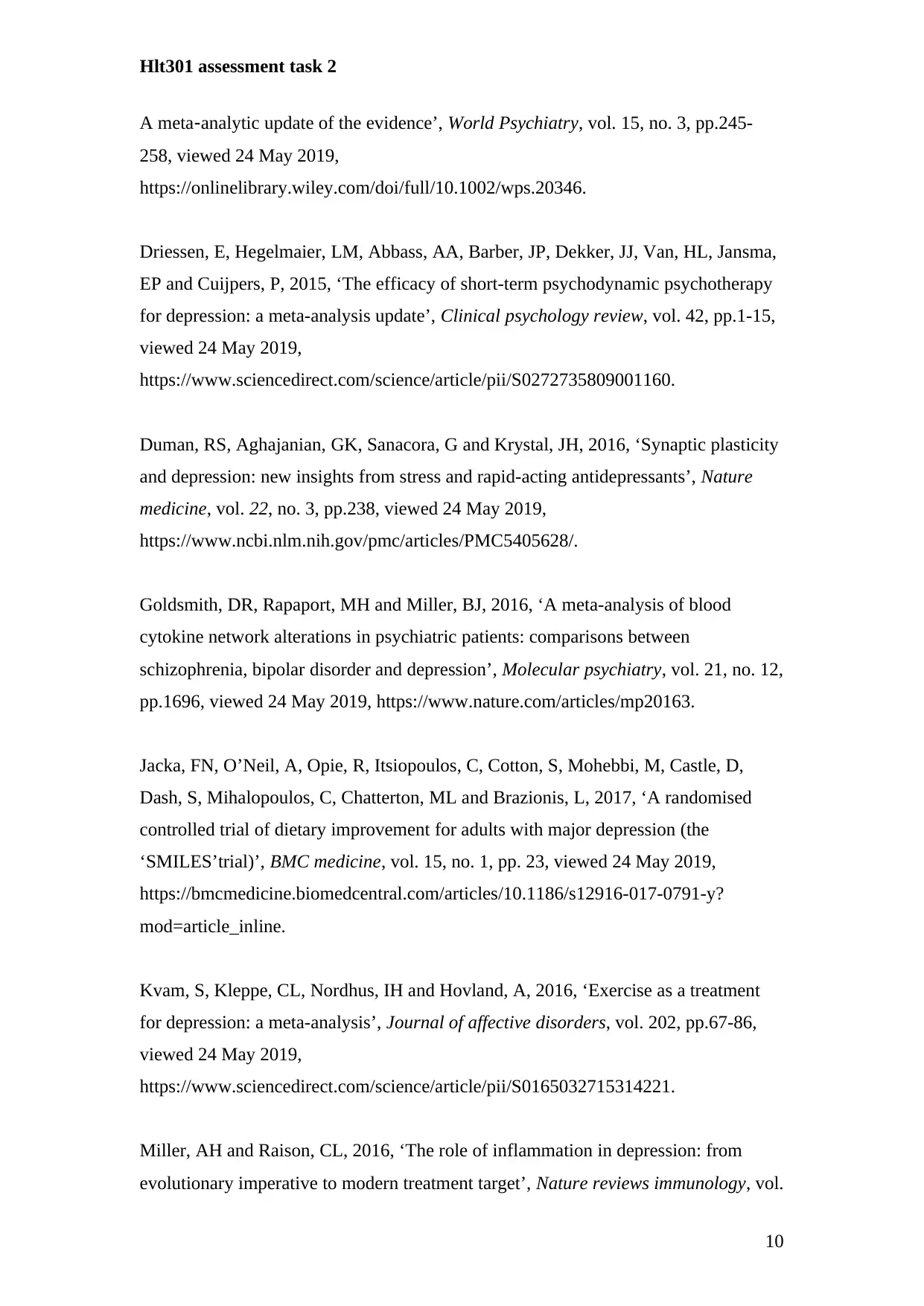
Hlt301 assessment task 2
A meta‐analytic update of the evidence’, World Psychiatry, vol. 15, no. 3, pp.245-
258, viewed 24 May 2019,
https://onlinelibrary.wiley.com/doi/full/10.1002/wps.20346.
Driessen, E, Hegelmaier, LM, Abbass, AA, Barber, JP, Dekker, JJ, Van, HL, Jansma,
EP and Cuijpers, P, 2015, ‘The efficacy of short-term psychodynamic psychotherapy
for depression: a meta-analysis update’, Clinical psychology review, vol. 42, pp.1-15,
viewed 24 May 2019,
https://www.sciencedirect.com/science/article/pii/S0272735809001160.
Duman, RS, Aghajanian, GK, Sanacora, G and Krystal, JH, 2016, ‘Synaptic plasticity
and depression: new insights from stress and rapid-acting antidepressants’, Nature
medicine, vol. 22, no. 3, pp.238, viewed 24 May 2019,
https://www.ncbi.nlm.nih.gov/pmc/articles/PMC5405628/.
Goldsmith, DR, Rapaport, MH and Miller, BJ, 2016, ‘A meta-analysis of blood
cytokine network alterations in psychiatric patients: comparisons between
schizophrenia, bipolar disorder and depression’, Molecular psychiatry, vol. 21, no. 12,
pp.1696, viewed 24 May 2019, https://www.nature.com/articles/mp20163.
Jacka, FN, O’Neil, A, Opie, R, Itsiopoulos, C, Cotton, S, Mohebbi, M, Castle, D,
Dash, S, Mihalopoulos, C, Chatterton, ML and Brazionis, L, 2017, ‘A randomised
controlled trial of dietary improvement for adults with major depression (the
‘SMILES’trial)’, BMC medicine, vol. 15, no. 1, pp. 23, viewed 24 May 2019,
https://bmcmedicine.biomedcentral.com/articles/10.1186/s12916-017-0791-y?
mod=article_inline.
Kvam, S, Kleppe, CL, Nordhus, IH and Hovland, A, 2016, ‘Exercise as a treatment
for depression: a meta-analysis’, Journal of affective disorders, vol. 202, pp.67-86,
viewed 24 May 2019,
https://www.sciencedirect.com/science/article/pii/S0165032715314221.
Miller, AH and Raison, CL, 2016, ‘The role of inflammation in depression: from
evolutionary imperative to modern treatment target’, Nature reviews immunology, vol.
10
A meta‐analytic update of the evidence’, World Psychiatry, vol. 15, no. 3, pp.245-
258, viewed 24 May 2019,
https://onlinelibrary.wiley.com/doi/full/10.1002/wps.20346.
Driessen, E, Hegelmaier, LM, Abbass, AA, Barber, JP, Dekker, JJ, Van, HL, Jansma,
EP and Cuijpers, P, 2015, ‘The efficacy of short-term psychodynamic psychotherapy
for depression: a meta-analysis update’, Clinical psychology review, vol. 42, pp.1-15,
viewed 24 May 2019,
https://www.sciencedirect.com/science/article/pii/S0272735809001160.
Duman, RS, Aghajanian, GK, Sanacora, G and Krystal, JH, 2016, ‘Synaptic plasticity
and depression: new insights from stress and rapid-acting antidepressants’, Nature
medicine, vol. 22, no. 3, pp.238, viewed 24 May 2019,
https://www.ncbi.nlm.nih.gov/pmc/articles/PMC5405628/.
Goldsmith, DR, Rapaport, MH and Miller, BJ, 2016, ‘A meta-analysis of blood
cytokine network alterations in psychiatric patients: comparisons between
schizophrenia, bipolar disorder and depression’, Molecular psychiatry, vol. 21, no. 12,
pp.1696, viewed 24 May 2019, https://www.nature.com/articles/mp20163.
Jacka, FN, O’Neil, A, Opie, R, Itsiopoulos, C, Cotton, S, Mohebbi, M, Castle, D,
Dash, S, Mihalopoulos, C, Chatterton, ML and Brazionis, L, 2017, ‘A randomised
controlled trial of dietary improvement for adults with major depression (the
‘SMILES’trial)’, BMC medicine, vol. 15, no. 1, pp. 23, viewed 24 May 2019,
https://bmcmedicine.biomedcentral.com/articles/10.1186/s12916-017-0791-y?
mod=article_inline.
Kvam, S, Kleppe, CL, Nordhus, IH and Hovland, A, 2016, ‘Exercise as a treatment
for depression: a meta-analysis’, Journal of affective disorders, vol. 202, pp.67-86,
viewed 24 May 2019,
https://www.sciencedirect.com/science/article/pii/S0165032715314221.
Miller, AH and Raison, CL, 2016, ‘The role of inflammation in depression: from
evolutionary imperative to modern treatment target’, Nature reviews immunology, vol.
10
Paraphrase This Document
Need a fresh take? Get an instant paraphrase of this document with our AI Paraphraser
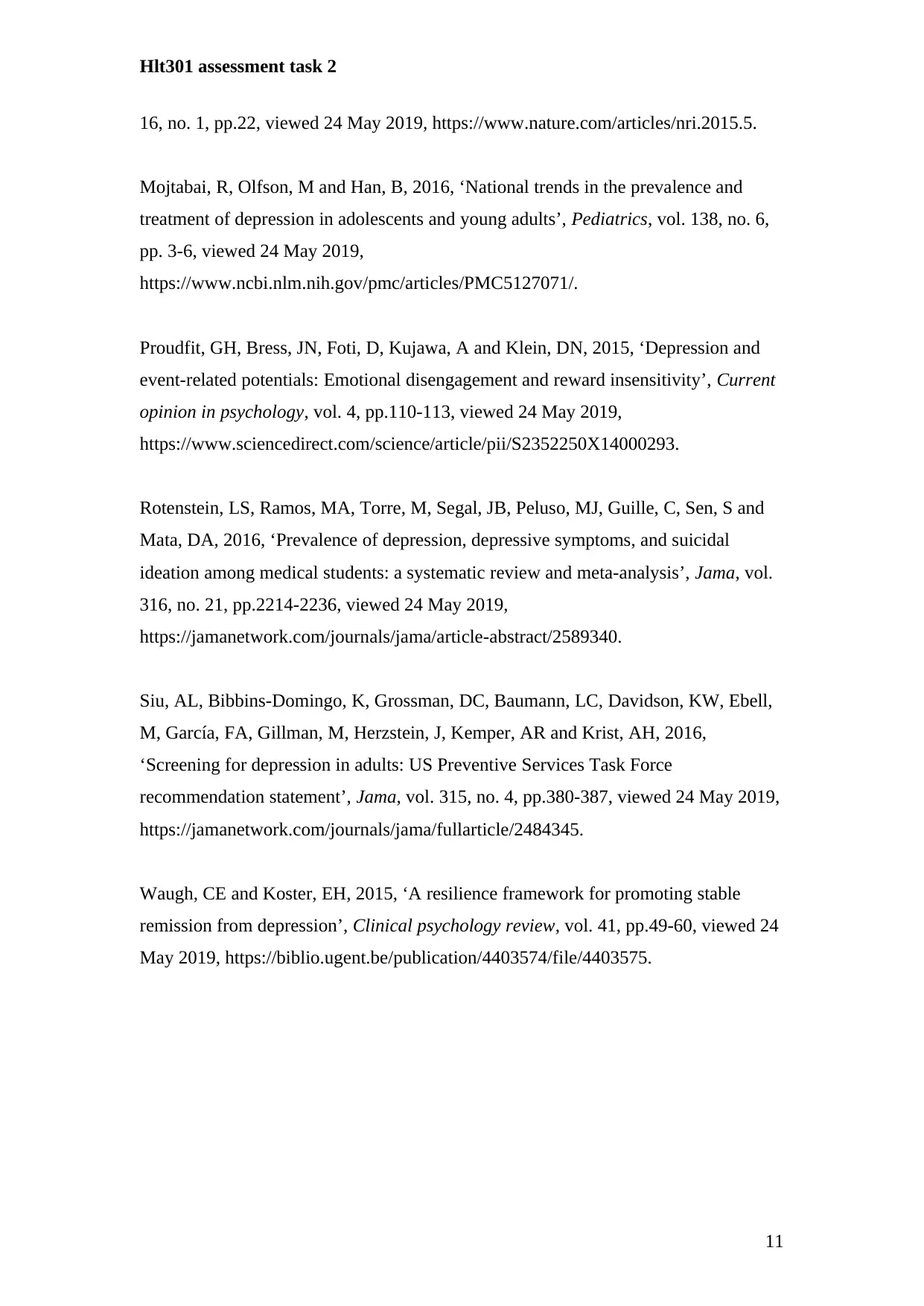
Hlt301 assessment task 2
16, no. 1, pp.22, viewed 24 May 2019, https://www.nature.com/articles/nri.2015.5.
Mojtabai, R, Olfson, M and Han, B, 2016, ‘National trends in the prevalence and
treatment of depression in adolescents and young adults’, Pediatrics, vol. 138, no. 6,
pp. 3-6, viewed 24 May 2019,
https://www.ncbi.nlm.nih.gov/pmc/articles/PMC5127071/.
Proudfit, GH, Bress, JN, Foti, D, Kujawa, A and Klein, DN, 2015, ‘Depression and
event-related potentials: Emotional disengagement and reward insensitivity’, Current
opinion in psychology, vol. 4, pp.110-113, viewed 24 May 2019,
https://www.sciencedirect.com/science/article/pii/S2352250X14000293.
Rotenstein, LS, Ramos, MA, Torre, M, Segal, JB, Peluso, MJ, Guille, C, Sen, S and
Mata, DA, 2016, ‘Prevalence of depression, depressive symptoms, and suicidal
ideation among medical students: a systematic review and meta-analysis’, Jama, vol.
316, no. 21, pp.2214-2236, viewed 24 May 2019,
https://jamanetwork.com/journals/jama/article-abstract/2589340.
Siu, AL, Bibbins-Domingo, K, Grossman, DC, Baumann, LC, Davidson, KW, Ebell,
M, García, FA, Gillman, M, Herzstein, J, Kemper, AR and Krist, AH, 2016,
‘Screening for depression in adults: US Preventive Services Task Force
recommendation statement’, Jama, vol. 315, no. 4, pp.380-387, viewed 24 May 2019,
https://jamanetwork.com/journals/jama/fullarticle/2484345.
Waugh, CE and Koster, EH, 2015, ‘A resilience framework for promoting stable
remission from depression’, Clinical psychology review, vol. 41, pp.49-60, viewed 24
May 2019, https://biblio.ugent.be/publication/4403574/file/4403575.
11
16, no. 1, pp.22, viewed 24 May 2019, https://www.nature.com/articles/nri.2015.5.
Mojtabai, R, Olfson, M and Han, B, 2016, ‘National trends in the prevalence and
treatment of depression in adolescents and young adults’, Pediatrics, vol. 138, no. 6,
pp. 3-6, viewed 24 May 2019,
https://www.ncbi.nlm.nih.gov/pmc/articles/PMC5127071/.
Proudfit, GH, Bress, JN, Foti, D, Kujawa, A and Klein, DN, 2015, ‘Depression and
event-related potentials: Emotional disengagement and reward insensitivity’, Current
opinion in psychology, vol. 4, pp.110-113, viewed 24 May 2019,
https://www.sciencedirect.com/science/article/pii/S2352250X14000293.
Rotenstein, LS, Ramos, MA, Torre, M, Segal, JB, Peluso, MJ, Guille, C, Sen, S and
Mata, DA, 2016, ‘Prevalence of depression, depressive symptoms, and suicidal
ideation among medical students: a systematic review and meta-analysis’, Jama, vol.
316, no. 21, pp.2214-2236, viewed 24 May 2019,
https://jamanetwork.com/journals/jama/article-abstract/2589340.
Siu, AL, Bibbins-Domingo, K, Grossman, DC, Baumann, LC, Davidson, KW, Ebell,
M, García, FA, Gillman, M, Herzstein, J, Kemper, AR and Krist, AH, 2016,
‘Screening for depression in adults: US Preventive Services Task Force
recommendation statement’, Jama, vol. 315, no. 4, pp.380-387, viewed 24 May 2019,
https://jamanetwork.com/journals/jama/fullarticle/2484345.
Waugh, CE and Koster, EH, 2015, ‘A resilience framework for promoting stable
remission from depression’, Clinical psychology review, vol. 41, pp.49-60, viewed 24
May 2019, https://biblio.ugent.be/publication/4403574/file/4403575.
11
1 out of 11
Related Documents
Your All-in-One AI-Powered Toolkit for Academic Success.
+13062052269
info@desklib.com
Available 24*7 on WhatsApp / Email
![[object Object]](/_next/static/media/star-bottom.7253800d.svg)
Unlock your academic potential
Copyright © 2020–2025 A2Z Services. All Rights Reserved. Developed and managed by ZUCOL.





